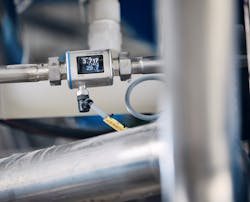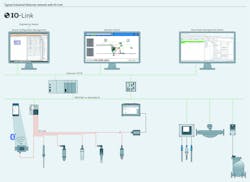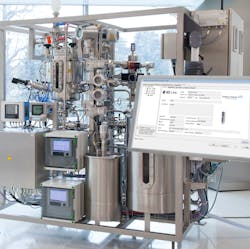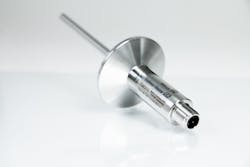Ease instrument commissioning and enhance maintenance with IO-Link
Ask any plant manager, operator, or engineer with more than a few weeks of experience, and they can recall multiple instances attempting to troubleshoot issues with insufficient information available. To address this and related issues, many technological innovations are filling in the informational voids, aiding root cause analysis.
In the instrumentation realm, advancements in device diagnostics are making scores of data points available for consumption by central host systems, supplementing historical process data and increasing maintenance, repair, and operational insights. Modern digital communication protocols provide the backbone for receiving all this data, which is natively suited for monitoring and analysis in edge or cloud computational engines, without the need to convert analog measurement signals.
There are various industrial Ethernet protocols and fieldbuses that form these digital pathways, but in many applications, such comprehensive technologies add unnecessary installation and design complexity to systems that require only simple diagnostic capabilities.
IO-Link is a lighter digital protocol, easier to configure and at a lower cost to install and maintain than fieldbus and Ethernet-based communication packages, while still providing most, if not all, of the required diagnostic and process data points digitally to a central host system. This manufacturer-agnostic open protocol was developed as a simple and universal solution, requiring only standard M12 cables and connectors. IO-Link is applicable to both analog instruments, such as one used to measure temperature, and discrete sensors, such as a limit switch, with the term “instruments” used throughout this article to represent both types of devices.
With an estimated 27 million nodes in operation worldwide as of 2021 and a rapidly-growing base, especially in food & beverage facilities, IO-Link is supported by a wide and growing range of instruments, providing data-rich visibility, along with other benefits of digital technology.
Traditional communication shortcomings
Many plants today are performing process measurements using conventional instrumentation, and most of these measurements are transmitted to a host control system—such as a programmable logic controller (PLC) or distributed control system (DCS)—via 4-20mA analog current signals.
While industrially robust, there are many factors that can interfere with the performance and quality of these instruments’ measurements and analog outputs. Because traditional 4-20mA instruments scale a single process value as electrical current, there is no ability to transmit secondary variables or diagnostic data.
Without instrument diagnostic data, it is challenging for operators to know whether the 4-20mA signal processed by a central host system is accurate. Additionally, communication is one-way only, so there is no means to send commands from a host system to an instrument.
Paths for upgrade
By incorporating smart instrumentation into plant designs, facility operation and optimization become much more manageable tasks. These instruments incorporate digital communication protocols, sometimes in place of—and other times superimposed on, in the case of HART—traditional analog communication protocols, greatly increasing capabilities and value. In fact, is estimated that 90% of all analog instruments installed already have digital HART capabilities, but 97% of these remain unused.
For retrofitted applications where hardwiring transmitters back to a host system is convenient, instruments can use the two-way digital HART communication protocol. It is superimposed on an analog current loop, and it enables sending and receiving of data with a local calibration device or host system.
The exchanged data includes diagnostic, calibration, maintenance, process, and other information, increasing configuration ease and operational process insights as compared to traditional analog-only instrumentation.
Transmitting this data is also possible via Ethernet-based protocols, which provide many of the same benefits as HART, but they typically operate at higher speeds, enabling inclusion of more information, along with faster response times. Wireless data transmission options—including Bluetooth, WLAN, and WirelessHART—are also available for many modern instruments.
IO-Link fills a sweet spot
While each of these digital protocols has ideal uses, IO-Link possesses a unique set of advantages for many applications, combining simple configuration, a standardized protocol, fast data transmission speeds, and low cost. Recognized as an international standard, IEC 61131-9, IO-Link is a bidirectional digital communications protocol. It provides measurement and other devices with basic functionality, most notably instrument diagnostic information (Figure 1).
Similar to a remote input/output (I/O) hub, an IO-Link “master” device is used to connect multiple instruments to a host system via an industrial Ethernet protocol, such as EtherNet/IP, PROFINET, or Modbus-TCP/IP. The master serves as a gateway, transmitting diagnostic data, secondary process values, and host system commands among all connected devices (Figure 2).
Integrating IO-Link-capable instruments is especially popular among machine builders and skid suppliers in the food & beverage industry. This is because basic instruments with support for IO-Link fulfill most operational requirements, while the diagnostics of IO-Link can drastically improve troubleshooting efforts when issues arise. The installation requirements of fieldbuses add complexity and costs, and by contrast, IO-Link instruments are about as close to “plug-and-play” as any come.
Additionally, the majority of IO-Link instruments can be optionally operated in 4–20mA analog mode with simple configuration and wiring changes, enabling flexible installation and integration. When ready, facilities can switch the devices to digital mode to harness the power of offline parametrization, increased instrument diagnostic data, and multiple process variables transmitted from a single instrument.
This includes provision of secondary process values, such as temperature, alongside a main measurement, or continuous measurement values alongside a switch status. Some standard diagnostic data points indicate:
- Is the device active?
- Is each process value valid?
- Hours of operation
- Marginal operations
- Overload conditions
- Device identification information
- Instrument error codes.
IO-Link functions as a compelling alternative to simply monitoring non-digital devices, like 4-20mA transmitters or digital input switches, which only permit a single process variable per cable pair. These traditional instruments also require scaling and local configuration, operations that must be repeated manually every time a device is exchanged.
By contrast, IO-Link-enabled instruments come ready out of the box, retaining the full resolution of measured values for transmittance to a host system. Using M12 washdown grade connectors and unshielded cables up to 20 meters in length, it is easy to deploy large quantities of IO-Link instrumentation in a short span of time.
Standard configuration software is readily available, and it is often hosted on the IO-Link master’s web server, accessible in any browser through a network-connected cell phone, laptop, or tablet. The software’s intuitive interfaces graphically guide users through parametrization, and this can be performed remotely through a network-accessible master device, reducing commissioning time during startup, and troubleshooting time during operation (Figure 3).
In the event of device failure, replacement is simple because parametrization can be stored and saved online or offline, and quickly loaded when a new master or instrument is placed in service. Because IO-Link is a standardized technology, every instrument implemented according to specifications works with any manufacturer’s master, providing users with flexibility for instrument selection.
Compared to instrumentation with direct Ethernet connectivity, IO-Link devices are not directly accessible from an upper-level system, such as an asset management system. Instead, users must tunnel through the IO-Link master to reach them. However, faster data polling speeds make this quicker than connecting to instruments via HART. But the greatest strength of IO-Link systems is the simplicity of instrument configuration and ease of device replacement, reducing the level of training required to maintain and service plant instrumentation.
Industry 4.0 capabilities for the digital future
Upgrading analog instrumentation with digital capabilities provides a number of CapEx benefits for machine builders and end users, including simpler design, easier commissioning, and faster startup. Digital technologies in general, and IO-Link in particular, provide fast device data exchange, precise transmission accuracy, multiple process value measurements per device, and many diagnostic data points. These capabilities can be used to improve operations and maintenance throughout instrument lifecycles.
Sustaining a competitive edge in the food & beverage industry requires topnotch production efficiency, among many other practices, and a wide variety of products are comprised of perishable raw materials, which are subject to loss if improperly stored. For this and other reasons, precise monitoring of stock, hygiene, safety, and inventory conditions are crucial to minimize material waste and adhere to strict standards. IO-Link can help food and beverage processors that are challenged by the constant threat of loss and the difficulties of rigorous manual management.
Although most widely adopted in the food & beverage sector, IO-Link-capable instrumentation has something to offer processors across many industries because it helps expand visibility and generate holistic insights. These insights empower plant personnel to optimize operational efficiency, maintain product quality, and maximize profitability.
This story originally appeared in the November/December 2022 issue of Plant Services. Subscribe to Plant Services here.




